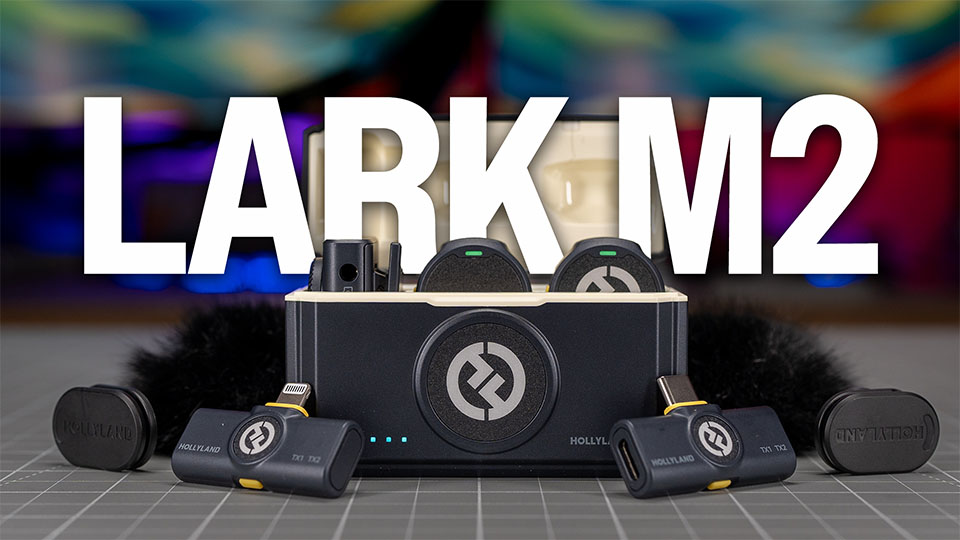Links in this post may be affiliate links. Any products purchased through affiliate links may provide a small commission which helps to support the SemiPro Tech+Gear site and YouTube channel.
In the rapidly evolving world of content creation, audio quality can make or break a video. While there are multiple options for wireless mic kits, Hollyland’s Lark M2 stands out as a compact and affordable solution. Here we dive into an in-depth review of the Hollyland Lark M2, exploring its features, compatibility, and overall performance. Whether you’re a budding YouTube star or a seasoned vlogger, understanding the nuances of this tiny tech marvel will help you decide if it’s the right fit for your audio needs.
Hollyland Lark M2
MSRP: $179 USD (combo kit)
Pros
- Ultra-compact transmitters
- Good sound quality with 24-bit conversion
- Versatile receiver options catering to a plethora of devices
- Good battery life
- Straightforward and user-friendly
Cons
- Camera receiver can only deliver two-channel stereo output via 3.5mm, not USB
- Mini receivers may not fit snugly on phones with thicker cases
- Not well-suited for environments with 2.4 GHz interference due to no internal recording backup
Best For: Content creators who don’t need internal recording and value compact size over extra features.
Features and Specifications
The Lark M2 comes with two microphone transmitters, but the kit is available in four variations based on which receiver(s) you need. You can get a single mini-receiver for USB-C or lightning connections ($139), a camera receiver with 3.5mm and USB outputs ($159), or a combo kit that includes all the receivers ($179). Each kit also includes a charging case for the transmitters and multiple accessories including connectors, wind muffs, magnets with clips, lanyards, and stickers to personalize or mask the Hollyland logo.
The Lark M2 is designed for plug-and-play simplicity. Unboxing to recording is a breeze with the easy-to-connect receiver and transmitters that require no complex setup. The transmitters are truly tiny, weighing a minute 9 ounces and being much less noticeable than some other kits when worn on the outside of clothing. Most other wireless mic transmitters seem huge by comparison.

The transmitters offer 24-bit audio at a 48 kHz sample rate, ensuring your recordings retain their quality. There is a noise reduction feature that can be activated on the transmitters, the micro-receivers, and in the Lark Sound mobile app, though it does impart a fair amount of digital artifacts to the sound (samples in the video above). Frequency response of the transmitter mics is 20Hz-20kHz, and signal to noise ratio is >70dB. Range of the transmitters is stated as 300 meters or 1,000ft, however in my testing the range performance, while average and perfectly usable in my opinion, wouldn’t be reliable at those distances. At a distance of 50 meters the signal cut out when I turned my back to the camera. It worked with clear line of sight for me up to 100 meters, which is a fairly extreme distance to be from your camera (especially if you record alone).
The USB output of all receivers is only available in mono, meaning the signal from both transmitters will be merged into one audio channel. When using the 3.5mm output of the camera receiver, you can enable 2-channel stereo output where each transmitter will be recorded in a separate channel (left and right). This enables editing of the audio from each transmitter separately in post (helpful if one speaker makes a sound like a sneeze or cough while the other speaker is talking).
Battery life of the transmitters is 10 hours with noise reduction off, which is excellent for such a small size. The camera receiver life is about 9 hours, while the mini-receivers don’t require battery power as they are powered by the USB connection.
There are a couple features you won’t find on the Lark M2: internal recording or 3.5mm input for lavalier microphones. The transmitters do not have recording capabilities so if your signal drops out or encounters interference, you may have to reshoot. And you won’t be able to plug in a lavalier microphone to the transmitter, however with the transmitter being so tiny to begin with, that may be less of a necessity.
Pros and Cons: Weighing Your Options
The main benefits of the Lark M2 (audio quality being equal to many other options on the market), are the super-compact size of the transmitters and the ease of use. If those describe your top priorities, then the M2 may be a good fit. But if you require additional features like internal recording or the ability to connect lavalier mics, other options would be better suited.
The wind muffs included are effective at cutting wind noise, however they do cover the entire transmitter. A small arrow on the back (when the magnet is removed) will show you which direction the microphone is pointing, however you still cannot see the noise reduction button or the status light, so the user experience with the wind muff on has room for improvement.
Final Thoughts – Is the Hollyland Lark M2 for You?
Stacking the Lark M2 against its contemporaries like the Rode Wireless Go II, DJI Mic II, and Hollyland’s own Lark Max reveals where it stands in the market. Although lacking some features such as internal recording and lav mic input options, the Lark M2 holds its own in terms of compactness, sound quality, and price-point advantage.
Whether the Lark M2 is right for you depends on a couple of things but most importantly, the nature of your content. Specifically, where you regularly record and the type or style of content. The lack of internal recording as a backup for potential interference or dropped signals only becomes a serious issue under certain circumstances. If you primarily record in controlled spaces that don’t have a lot of 2.4GHz air traffic, such as at home, then interference is less likely. And if your main content style is scripted or short-form, then if you should have an audio issue it’s not much more than an annoyance to have to reshoot.
However if your content is frequently recorded in busy public spaces, or especially places with lots of competing 2.4GHz signals where interference is more likely – reporting at conventions or trade shows is a prime example – then internal recordings can be very valuable. Likewise, if your content is primarily the type that cannot be repeated – interviews, events, or other “one time only” content – then bad audio can mean a scrapped project. If these scenarios sound like the norm for you, then a wireless mic kit that includes internal recording is likely a better choice.
If those concerns don’t apply, then the Lark M2 is a terrific option at a fair price.


